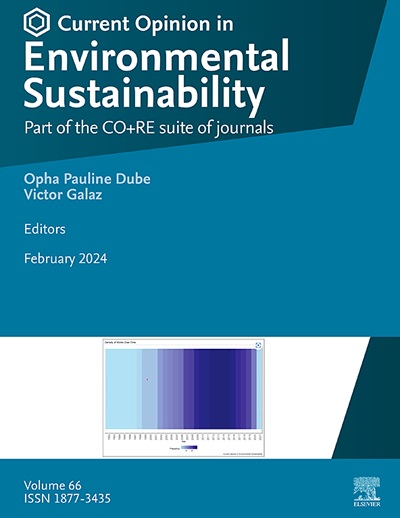Social limits to adaptation in the context of intangible cultural heritage
IF 6.3
2区 环境科学与生态学
Q1 ENVIRONMENTAL SCIENCES
Current Opinion in Environmental Sustainability
Pub Date : 2025-09-19
DOI:10.1016/j.cosust.2025.101569
引用次数: 0
Abstract
Amid mounting evidence of limited progress in adapting to climate change, scholarship on the limits to adaptation is gaining renewed momentum. Nevertheless, there remains a dearth of studies examining human systems explicitly from the perspective of how and why the limits to adaptation have been exceeded. Such retrospective studies can shed light on why these limits were exceeded in the first place and how communities responded. This article explores these issues in the context of intangible cultural heritage affected by climate change. It finds that adaptation faces biophysical constraints that are, in most cases, insurmountable. For this reason, efforts to overcome them are rare. In contrast, responses to the impacts of climate change on intangible cultural heritage are more common. They encompass four main types of actions: practical, organisational, culture grounded, and psychology informed. The article illustrates these issues with examples drawn from the scientific literature. It concludes by reflecting on the temporal dimension of limits to adaptation.
非物质文化遗产背景下适应的社会限制
越来越多的证据表明,在适应气候变化方面取得的进展有限,关于适应局限性的学术研究正在重新获得动力。然而,仍然缺乏从如何以及为什么超过适应极限的角度明确检查人类系统的研究。这样的回顾性研究可以揭示为什么这些限制会被超越,以及社区如何应对。本文以受气候变化影响的非物质文化遗产为背景,探讨这些问题。它发现适应面临着生物物理限制,在大多数情况下,这些限制是无法克服的。由于这个原因,克服它们的努力很少。相比之下,应对气候变化对非物质文化遗产影响的措施更为普遍。它们包括四种主要类型的行动:实践行动、组织行动、文化行动和心理行动。这篇文章用科学文献中的例子来说明这些问题。最后,它反思了适应极限的时间维度。
本文章由计算机程序翻译,如有差异,请以英文原文为准。
求助全文
约1分钟内获得全文
求助全文
来源期刊

Current Opinion in Environmental Sustainability
ENVIRONMENTAL SCIENCES-ENVIRONMENTAL SCIENCES
CiteScore
13.80
自引率
2.80%
发文量
52
审稿时长
6-12 weeks
期刊介绍:
"Current Opinion in Environmental Sustainability (COSUST)" is a distinguished journal within Elsevier's esteemed scientific publishing portfolio, known for its dedication to high-quality, reproducible research. Launched in 2010, COSUST is a part of the Current Opinion and Research (CO+RE) suite, which is recognized for its editorial excellence and global impact. The journal specializes in peer-reviewed, concise, and timely short reviews that provide a synthesis of recent literature, emerging topics, innovations, and perspectives in the field of environmental sustainability.
 求助内容:
求助内容: 应助结果提醒方式:
应助结果提醒方式:


